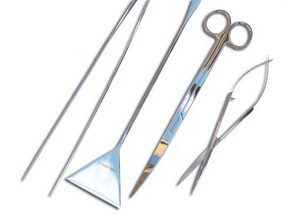Technical Requirements for Aquascaping
There are a few prerequsites you need for the maintenance of an attractive aquarium with lush plant growth. The plants in your tank require the full spectrum of nutrients, light and CO2 to remain healthy and to grow well. A good plant growth is the basis on which every aquascape is built, and for the keeper it is thus important to know the fundamentals of plant care. Aquarium equipment has undergone an amazing technical development in the last years, and there are many possibilities to set up your tank. When it comes to lighting, most aquarium plants have a minimum requirement of at least 0.5 W per litre of the tank volume; the most recommendable lighting media are T5, T8 or HQI lamps. With this kind of lighting, you can choose practically any plant for your aquascape. We do not recommend the use of higher light intensities, as these could cause problems due to the much more complicated handling of fertilizers and CO2 they require. You could even use less light for your tank, however, you should remember to adapt your choice of plants to the lighting intensity then. A weaker light is suitable for keeping e.g. mosses, Cryptocorynes, Anubias or ferns.

Without a full spectrum of nutrients, plants cannot and will not grow. Depending on the water you use and how highly your tank is stocked the plants will have to be supplied with additional nutrients through a fertilizer. Sometimes a waterplant fertilizer with iron commonly found in the pet trade will do in order to provide your plants with the micronutrients they need. However, if your tank has strong lighting and is well planted, it can develop a lack of macronutrients, mainly of nitrate, phospate and potassium. Thus you ought to consider adding these macronutrients specifically so your plants can continue to flourish. The supply with CO2 plays an enormous role for aquatic plants, too, carbon dioxide is one of their main nutrients. The more light you have over your tank, the more CO2 has to be added. For an aquascape, relatively high levels of CO2 have proven essential. If your light is less intensive, you can lower these levels without having to fear a decrease in plant health and growth.

The substrate plays a considerable part in supplying the plants with nutrients. As a rule, aquatic plants can absorb nutrients over their foliage as well as over their roots. A pre-fertilized substrate like e.g. the soils usually originating from Japan provides them with a vast supply of nutrients in the ground. Then you needn't add the full dosage of fertilizer to the water column. However, the amount of light over the tank is crucial again, in general, less intensively lit tanks need less fertilizer than strongly lit tanks. In a tank with less light, the nutrients present in the soil might already be sufficient to supply the plants with everything they need. If you are acquainted with the technical accessories of your tank, you can fully concentrate on the creative elements and give your imagination full scope.
